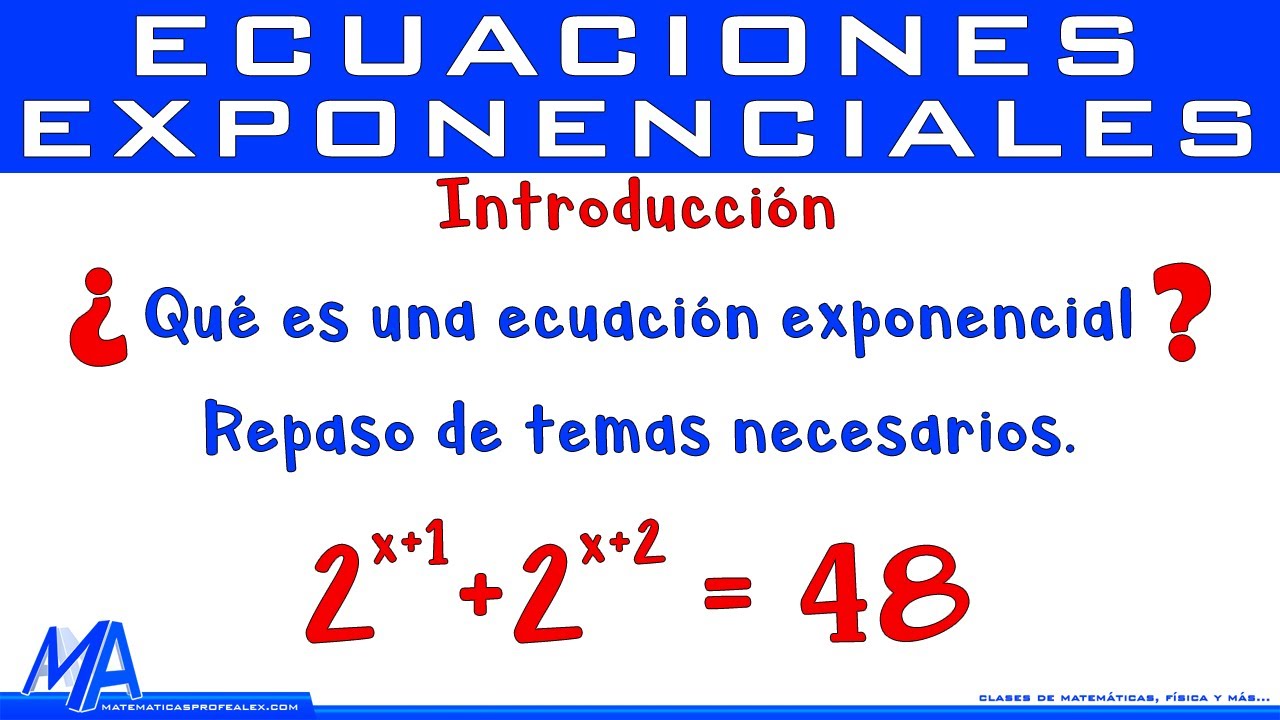Matematika SMA - Persamaan Eksponen (2) - Bentuk a^f(x)=a^g(x)
Summary
TLDRIn this video, the host continues to explain exponential equations with a focus on equations where both sides have the same base, but different functional exponents. The video demonstrates the process of solving these types of equations with several examples, such as equations involving fractions, roots, and quadratic functions. The host also encourages viewers to join the channel's membership for additional benefits and access to exclusive content. By breaking down complex problems step by step, the video aims to make exponential functions more accessible for learners.
Takeaways
- 😀 Learn about solving exponential equations with the same base but different powers in the form of functions.
- 😀 You can become a member of the Legurless channel with three membership levels: Linear, Quadratic, and Cubic, each offering unique benefits.
- 😀 Exponential equations with the same base can be solved by equating the exponents once the base numbers match.
- 😀 Example: 3^(2x-8) = 81 can be rewritten with a common base of 3, simplifying to solve for x.
- 😀 Solving more complex equations involves manipulating exponents, such as with roots and fractional powers.
- 😀 The equation 2^(2x+6) = 2^(3x+15)/4 can be solved by equating exponents after clearing the fraction.
- 😀 In quadratic exponential equations, break down the equation by equating the exponents and simplifying.
- 😀 Example: Solve 5^(x²+6x-42) = 5^60-5x by factoring and using the same base to find the values of x.
- 😀 Fractions and roots can be handled the same way as other exponential equations, such as 3^(x+8/3) = 3^(-9+6x).
- 😀 Quadratic equations resulting from exponential functions can often be solved by factoring or using the quadratic formula.
- 😀 Encourage viewers to practice and engage with the content by working through problems and checking solutions.
Q & A
What is the main focus of this video tutorial?
-The video tutorial focuses on solving exponential equations where the base is the same, but the exponents are in the form of different functions. It provides step-by-step examples to guide viewers through solving these types of equations.
How do we solve exponential equations with the same base but different functions as exponents?
-To solve exponential equations with the same base but different functions as exponents, you equate the exponents after ensuring the base is the same on both sides of the equation. Then, solve the resulting equation for the variable.
In the example with 3^(2x - 8) = 81, how did the base change?
-In this example, 81 was rewritten as 3^4. This allowed the equation to have the same base (3) on both sides, enabling the exponents to be equated for solving the variable x.
What is the first step in solving an exponential equation like 2^(2x + 6) = 2^(3x + 15)?
-The first step is to rewrite both sides of the equation with the same base, in this case, 2. Once the bases are the same, equate the exponents and solve for x.
How do you handle fractions and roots in exponential equations?
-When dealing with fractions or roots in exponential equations, express them as exponents. For example, the cube root of a number can be written as raising that number to the power of 1/3.
What is the significance of the quadratic equation that appears in the examples?
-The quadratic equation in the examples is often a result of manipulating the exponents or other components of the exponential equation. Solving these quadratic equations helps to find the value(s) of the variable x.
What does the equation 5^(x² + 6x - 42) = 5^(60 - 5x) represent in terms of solving for x?
-In this equation, the base 5 is the same on both sides, so we can equate the exponents, leading to the equation x² + 6x - 42 = 60 - 5x. This can then be solved using standard algebraic techniques, like factoring or the quadratic formula.
What is the solution for x in the equation 2^(2x - 6) = 2^(6/(x - 5))?
-After simplifying, we get the quadratic equation 2x² - 14x + 24 = 0. Solving this gives x = 3 or x = 4 as the solution set for the equation.
What steps are involved in factoring a quadratic equation like x² + 11x - 102 = 0?
-To factor the quadratic equation, first find two numbers that multiply to give -102 and add to give 11. These numbers are 17 and -6, so the equation factors as (x + 17)(x - 6) = 0. From here, solve for x by setting each factor equal to zero.
What is the importance of the membership levels mentioned in the video?
-The membership levels—linear, quadratic, and cubic—offer viewers additional benefits for supporting the channel. Each level provides different advantages, such as exclusive content or other perks, accessible by joining through the 'join' button on the channel.
Outlines

Dieser Bereich ist nur für Premium-Benutzer verfügbar. Bitte führen Sie ein Upgrade durch, um auf diesen Abschnitt zuzugreifen.
Upgrade durchführenMindmap

Dieser Bereich ist nur für Premium-Benutzer verfügbar. Bitte führen Sie ein Upgrade durch, um auf diesen Abschnitt zuzugreifen.
Upgrade durchführenKeywords

Dieser Bereich ist nur für Premium-Benutzer verfügbar. Bitte führen Sie ein Upgrade durch, um auf diesen Abschnitt zuzugreifen.
Upgrade durchführenHighlights

Dieser Bereich ist nur für Premium-Benutzer verfügbar. Bitte führen Sie ein Upgrade durch, um auf diesen Abschnitt zuzugreifen.
Upgrade durchführenTranscripts

Dieser Bereich ist nur für Premium-Benutzer verfügbar. Bitte führen Sie ein Upgrade durch, um auf diesen Abschnitt zuzugreifen.
Upgrade durchführen5.0 / 5 (0 votes)






